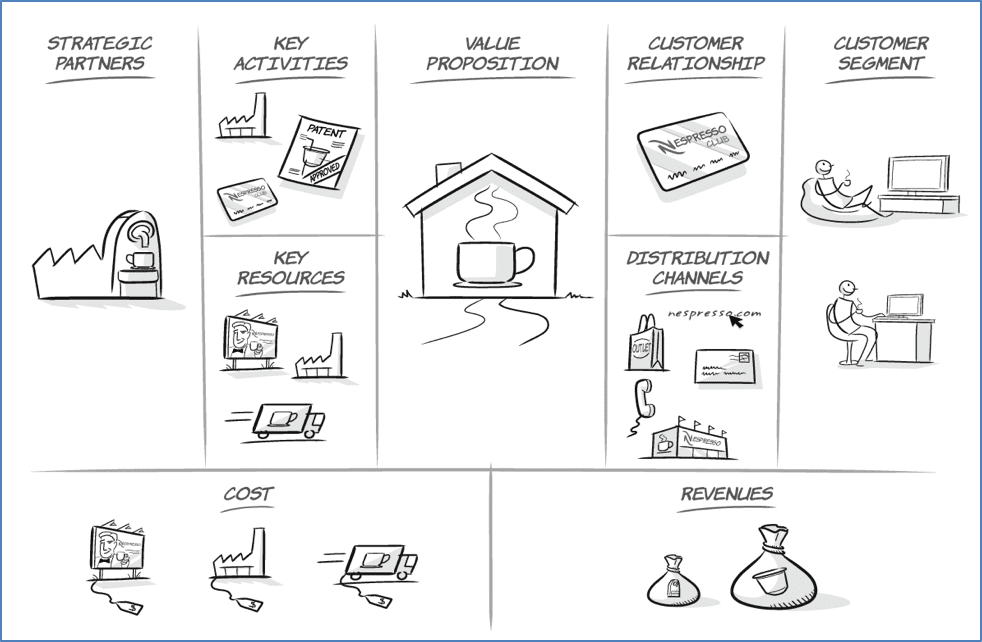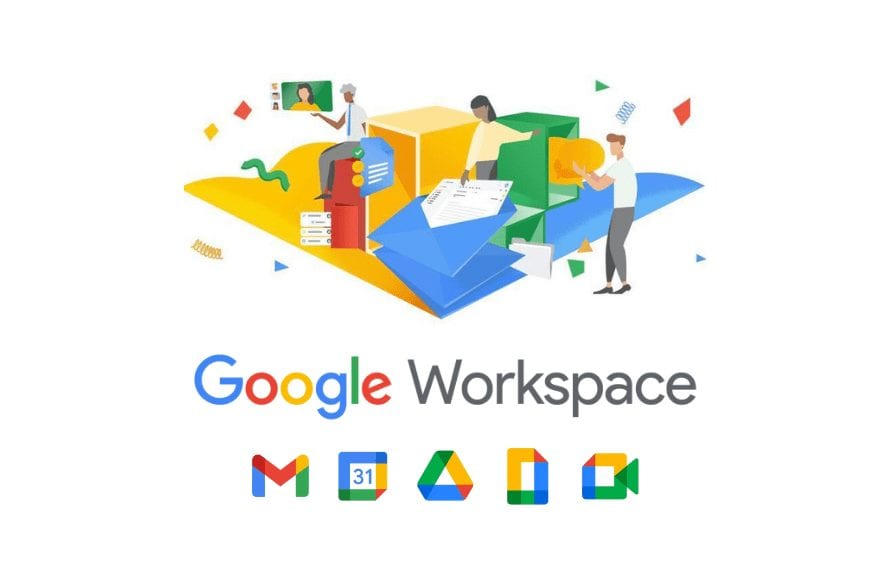With the business model canvas, you can draw up a business hypothesis that you then test with customers until you reach the point in the validation process where you have enough to go on and build a minimum viable product. As a home-based business owner, freelancer or hobbyist, you may have worked with the canvas before. But how does it work? How can you implement it? And why should you use it?
The Business Model Canvas can be mastered by putting the customer at the centre of your value proposition. According to this, you will brainstorm and place clear business ideas in the Business Model Canvas categories: Customer segments, Customer relationships, Channels, Value propositions, Core activities, Key resources, Key partners, Revenue streams, Cost structure. In this way, you can get a clear view of how your idea and/or your home-based business will work.
What is the Business Model Canvas?
As an entrepreneur, you are likely to work in multiple facets of the business, be it marketing, sales, customer support, operations, accounting, team management or any number of other roles. For each of these roles, you will probably need to take several steps to get your job done. Often you will have to make decisions about which people, systems or processes to focus on at any given time. In particular, you may need to build several iterations of the product or business model to keep your customers engaged and your business growing.
With the business model canvas, you can draw up a business hypothesis that you then test with customers until you reach the point in the validation process where you have enough to go on and build a minimum viable product. As a home-based business owner, freelancer or hobbyist, you may have worked with the canvas before. But how does it work? How can you implement it? And why should you use it?
The Business Model Canvas can be mastered by putting the customer at the centre of your value proposition. According to this, you will brainstorm and place clear business ideas in the Business Model Canvas categories: Customer segments, Customer relationships, Channels, Value propositions, Core activities, Key resources, Key partners, Revenue streams, Cost structure. In this way, you can get a clear view of how your idea and/or your home-based business will work.
What is the Business Model Canvas?
As an entrepreneur, you are likely to work in multiple facets of the business, be it marketing, sales, customer support, operations, accounting, team management or any number of other roles. For each of these roles, you will probably need to take several steps to get your job done. Often you will have to make decisions about which people, systems or processes to focus on at any given time. In particular, you may need to build several iterations of the product or business model to keep your customers engaged and your business growing.
How does it work?
Simply put, it is about turning that pre-existing intuition into something that makes sense in the context of your own business. You can use existing business models as a base and work backwards to design the initial core product that you will need. It’s an easier way of working than starting from scratch, and you can start with what you already have rather than starting from scratch and messing about creating something new. An accompanying checklist will guide you through the process. For example, as a web designer, you design a homepage, a landing page and any product pages. These are the first steps of the business model canvas, and you will work on these sections first.
A closer look at the Business Model Canvas
As a tool for strategic management and entrepreneurship, you can fill in the following segments in your Business Model Canvas brainstorming session:
- Customer segmentsWho are we solving a problem for, or fulfilling a need? Who are our customers? Does the value proposition match their needs and interests?
- Customer relationsHow will we acquire, retain and grow customers? How will we meet current and emerging customer needs?
- ChannelsWhich channels do our customer segments want to be reached through?
- Value propositionsWhat customer problems do we help solve? What customer needs do we satisfy? What is the specific offer, and any secondary offers? What features/benefits correspond to customer needs?
- Core businessWhich core activities require our value propositions?
- Key resourcesWhat key resources do our value propositions require?
- Key partnersWho are our key partners?
- Revenue streamsWhat is the revenue model, subsidies, earned income? What are the tactics in terms of prizes and donations? What impact / value are our customers willing to pay for?
- Cost structureWhat are the most important costs in our business model?
What are the advantages of using the Business Model Canvas?
It Business Model Canvas helps you to define your customers, pricing, distribution and delivery channel. It is a very useful tool for your long-term business planning, as it not only helps you develop an effective set of hypotheses for your business, but also saves you the time it takes to repeat your ideas manually. Here is a simple example of how you can use it to generate your hypothesis. Define the vertical segment you are going to test Define your primary vertical segment Define your ‘competitors’ (what are the major players in your vertical segment) Define the life cycle of your product. You are looking for a set of objectives to test and objectives to validate develop your hypotheses.
The Business Model Canvas is a tool for strategic management and entrepreneurship. It enables you to describe, design, challenge, invent and pivot your business model.- Strategyzer –
How can you build your business model canvas?
The Business Model Canvas is a way of mapping the value of the product you are building, the brand you are establishing and the market you are solving. I have found that the best way to move forward with the canvas is to use it as a starting point for conversations with other team members. That’s what I’m going to share with you today. Start by brainstorming five to seven words that describe the service you are creating and the value it will deliver to customers.
The creation of the canvas is usually done in a certain order, where you start with the most important parts and then build them up.
This way you can concentrate on each part separately and then work it out. A usual order would be:
- Customer segments
- Value proposition
- Customer relations
- Channels
- Main activities
- Key resources
- Main Partners
- Revenue streams
- Cost structure

Answer the nine segments in the Business Model Canvas
The canvas essentially asks you to explain how your existing or new business idea works in terms of nine interconnected key elements. It contains the essential components that make up the business model. This is what each component of the canvas means and what content it should contain:
Key partners – Persons or agencies, usually external, that contribute to part of your business canvas. These can be suppliers, affiliates, vendors and even competitors. Here you can examine what resources/services you get from partners and link this to how they add value.
Core business – The activities that directly or indirectly contribute to delivering the value proposition to customers/consumers. These can be elements of the value proposition, but also how they enable distribution channels, customer relationships and revenue streams.
Key Resources – The resources that contribute to the value proposition, channels, relationships and revenues. These resources can be tangible or intangible – i.e. include intellectual property, brand, hardware, software, finance, facilities and people.
Value Propositie – the core of the BMC is the Value Proposition – see below for more on this. A Value Proposition describes the real and perceived value you deliver to your customer and the challenge you solve for them/need you meet. Elements of a VP can include ease of use, design, brand/status, price, etc.
Customer relations – This concerns the type of relationship that each segment – consumer, donor, user, beneficiary – needs. For example, personal attention, self-service, community spirit, co-creation, etc. You can also describe the frequency of the relationship – one-off, regular, infrequent.
Distribution channels – This is where we look at how you plan to reach your customers – online, peer-to-peer, retail, wholesale, direct marketing, etc. You can, of course, have multiple channels – and different channels for acquisition and maintenance. And indeed different channels for different customers.
Customer segments – Here, you should describe the main clusters of customers you are dealing with – who actually benefits from the value you create? How do they relate to the Value Proposition?
Costs – This section outlines the main costs – direct and indirect – in the organisation. These are associated with the main resources and activities
Revenue – This deals with the ways in which you will make money. This could be how much are they willing to pay for the level of value you provide? Also consider how they would be willing to pay?
And for the social entrepreneurs?
The Business Model Canvas, or BMC, is a tool developed in recent years based on the work of Alex Osterwalder and Yves Pigneur. It was developed by Angela Cluff and Bernard Ross of =mc to make it useful for charities and NPOs who want to map out how their social enterprise works – in fundraising, in service delivery, or in running social enterprises.
Conclusion
Whether you are planning an online course, an e-commerce site, a product on Kickstarter or just want to create something for yourself, the Business Model Canvas can help you create a business model that can lead to the successful completion of your project. If you want a free plan and e-book that shows you how to create a product, check out the Business Model Canvas.
With the business model canvas, you can draw up a business hypothesis that you then test with customers until you reach the point in the validation process where you have enough to go on and build a minimum viable product. As a home-based business owner, freelancer or hobbyist, you may have worked with the canvas before. But how does it work? How can you implement it? And why should you use it?
The Business Model Canvas can be mastered by putting the customer at the centre of your value proposition. According to this, you will brainstorm and place clear business ideas in the Business Model Canvas categories: Customer segments, Customer relationships, Channels, Value propositions, Core activities, Key resources, Key partners, Revenue streams, Cost structure. In this way, you can get a clear view of how your idea and/or your home-based business will work.


